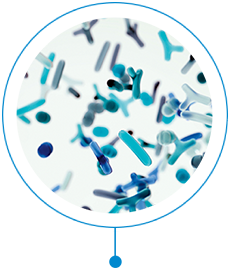
The gut microbiome—the microbial community in the intestinal tract—is an influencer of metabolism and immunity and a mediator of resistance to some pathogenic infections.1

A distinct and essential organ within the human body, the gut microbiome contains an estimated 500-1000 species and 100 trillion organisms, encoding 100-fold more unique genes than our own genome.1-4
In its balanced state, there is a symbiotic relationship between luminal bacteria and our human cells.5
These cells communicate and form long-lasting, interactive associations that play a vital role in conservation of mucosal immune function, epithelial barrier integrity, motility, and nutrient absorption.5-7
Dysbiosis is the disruption of the composition and/or diversity of the gut microbiome.
The causes of dysbiosis can be attributed to stress, diet, hygiene, and use of antibiotics. Dysbiosis has been associated with a range of different gastrointestinal (GI) and non-GI diseases including neurologic, metabolic, liver, inflammatory, and infectious diseases. Restoration of the gut microbiome homeostasis is essential to rectifying dysbiosis.5,8,9
While this often occurs as a natural process, therapeutic intervention may also be required.
